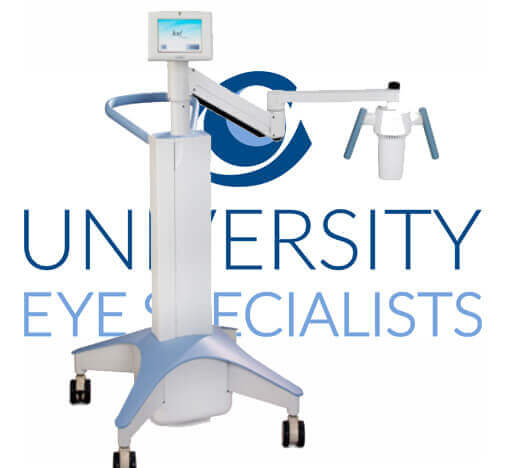Posted by: University Eye Specialists in Uncategorized

University Eye Specialists, Knoxville’s premier ophthalmology practice since 1935, is now the first and only practice in East Tennessee to offer the FDA approved cross-linking therapy for the treatment of keratoconus and corneal ectasia following refractive surgery – two progressive and sight threatening eye conditions that affect more than 160,000 Americans. Corneal cross-linking is used to stiffen corneas that have been weakened by disease or refractive surgery. Without treatment, patients may go on to require corneal transplant.
“Corneal cross-linking is beneficial to my patients in that it offers them a therapeutic option to limit the progression of keratoconus and ectasia”, says University Eye ophthalmologist and cornea specialist, Jordan Masters, M.D. “The FDA approval of corneal cross-linking with the avedro KXL system now offers a new treatment option for appropriate patients who previously had few options to help with their vision challenges and no therapeutic treatment for these sight-threatening conditions”, said Dr. Masters.
In keratoconus patients, the typically round, dome-shaped cornea progressively thins and weakens, causing the development of a cone-like bulge that produces optical irregularities that affect vision. A rare condition, keratoconus typically appears in individuals who are in their late teens or early twenties. Early symptoms include blurring or distortion of vision or increased sensitivity to light. Corneal ectasia, also marked by progressive corneal steepening and thinning, is a rare but serious complication resulting from vision correction procedures—such as laser-assisted in-situ keratomileusis (LASIK) and photorefractive keratectomy (PRK), and is associated with worsening vision.
Corneal cross-linking is a medical procedure that combines the use of ultra-violet (UV) light and riboflavin (vitamin B2) eye drops. The procedure works by creating new corneal collagen cross-links, which results in a shortening and thickening of collagen fibrils that leads to the stiffening the cornea. Cross-linking, which has been performed in Europe since 2003, is considered the standard of care around the world for keratoconus and corneal ectasia following refractive surgery.
“Early diagnosis is critical and allows patients to be treated early in the disease course before progressing to the point of needing a corneal transplant,” added Dr. Masters. “Patients suffering from progressive keratoconus and corneal ectasia following refractive surgery can now receive a therapeutic treatment that has been rigorously tested and approved.”
To determine if corneal cross-linking may be right for them, patients can contact University Eye Specialists at 865-244-2020 or through our website at universityeye.com.
Tags: cornea, knoxville, ophthalmology, optometry

